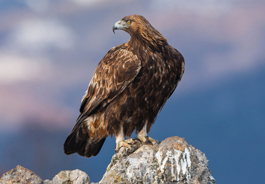Lead Toxicity in Wild Birds
A Case for Requiring Non-Lead Ammunition
by Vickie Joseph, DVM
June 24, 2013
 Lead poisoning poses a serious threat to many wildlife species, including golden eagles. blickwinkel/AlamyAs a veterinarian with expertise in rehabilitating ill and injured wild birds, I have unfortunately treated numerous birds who have suffered from lead poisoning over the past 30 years. It takes such a small amount of lead to cause immense suffering for these birds and, despite intensive care, sadly many do not survive.
Such was the case of a golden eagle that was presented at my Northern California clinic, the Bird and Pet Clinic of Roseville, this spring with lead toxicity. This majestic bird was found on the ground unable to fly. She could still move her wings, but her legs were paralyzed. At the clinic, her blood lead levels were tested with the in-house blood lead analyzer. The reading was off the scale. In addition to leg paralysis, the bird could not move her tongue normally, and she also suffered from central nervous system deficits. After three weeks of an intense therapy regime, the eagle succumbed to respiratory failure secondary to the neurologic effects of lead toxicity. No fungal infection was found on necropsy. Full necropsy results are still pending.
My experience in treating lead-poisoned birds like this golden eagle has led me to support efforts such as the bill currently pending in the California State Senate, Assembly Bill 711 (authored by Assemblymembers Anthony Rendon, D-Lakewood and Dr. Richard Pan, D-Sacramento), which would require all hunters in the state to use non-lead ammunition.
Wild birds can be poisoned by lead pellets found in wetlands and milled mining waste, and through ingestion of lead fishing weights and of contaminated prey species (lead shot embedded in the tissues of ducks, geese, rabbits, squirrels etc.), just to name a few. Chronic low-grade exposure comes from contaminated soil, plants and water. This type of exposure may affect a variety of avian species. High-grade exposure is from ingestion of lead and often affects waterfowl, granivorous birds, and raptors. Unfortunately, the toxic effects of lead may be passed through the egg, resulting in chick mortality.
Initially, lead toxicity affects the red blood cells. Transfer from the blood to the tissues is slow and varies with the type of salts the lead combines with, but if incorporated into the bone, the long-term effects of lead may last years. Lead affects red blood cell heme synthesis (involved with oxidative metabolism). This in turn may cause kidney impairment, liver dysfunction, delayed gastro-intestinal motility, and neurologic damage.
Raptors and waterfowl presenting with lead toxicity may show signs of weakness, inability to fly, and leg paralysis. Many of these birds are thin and often suffer from secondary infections related to the toxic effects of lead. Some victims may present with polydipsia/polyuria, regurgitation, stupor, blindness, and seizures.
Lead toxicity is diagnosed with radiographs and blood lead levels. In most raptor species, lead pellets will not be seen on radiographs. This is in contrast to the Turkey vulture, which often shows lead fragments in the gastrointestinal tract. The blood lead levels are a necessity to help monitor and gauge treatment. Complete blood counts and chemistries are also necessary to evaluate the bone marrow and organ functions. Secondary bacterial and fungal infections need to be identified and treated to ensure a full recovery for raptors and waterfowl.
Treatment is prolonged and expensive, sometimes costing thousands of dollars, and because most lead-poisoned animals are not privately owned, the cost is usually shouldered by non-profit wildlife rehabilitation centers and charitable organizations.
All birds with lead toxicity are started on fluid therapy to address the liver and kidney damage. Antibiotics and anti-fungals are also started on raptors and waterfowl. The lead chelation therapy starts with injectable CaEDTA. Once the gastrointestinal tract is functioning normally, oral chelation is started with DMSA. Often, both CaEDTA and DMSA are given simultaneously and the CaEDTA slowly stopped.
As was the case with the Golden Eagle mentioned above, a full diagnostic workup and therapy regime are typically implemented to try to save the animal. Another wild bird we recently treated for lead toxicity was a Turkey vulture. This bird had complete paralysis of the gastrointestinal tract as well as leg paralysis. A cropotomy had to be performed to remove the rotten food sitting in the crop. We also treated this bird with gastrointestinal motility drugs as well as lead chelation therapy to properly manage his case. Unfortunately, after initially showing signs of responding to treatment, this bird also did not survive.
The total length of treatment for most raptors takes one to three months. Permanent neurologic and vision issues may be present and often require persistent evaluation. Release back to the wild is only allowed if the bird shows complete recovery with the ability to fly, hunt, and secure food.
Given the severe health risks posed to avian and all wildlife species by lead contamination in the environment, it is important that veterinary professionals weigh in when attempts to keep toxic lead out of the environment are being considered.
More than 110 California veterinarians, including myself, have signed a statement supporting an end to the use of lead ammunition in California, and I urge any California veterinary professional who has not yet signed on to contact HSVMA for more information and to sign on.
Dr. Vickie Joseph owns the Bird and Pet Clinic of Roseville in Northern California. She specializes in avian care and rehabilitates ill and injured wild birds often working with the California Foundation for Birds of Prey. |